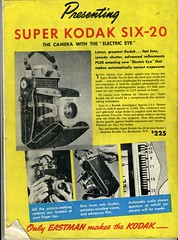(deleted photos withdrawn permission) |
Danipuntocom (talk | contribs) m (→Links) |
||
| Line 32: | Line 32: | ||
* [http://www.nationalmediamuseum.org.uk/Collections/Collection_Detail.asp?ItemID=32&SectionID=2&index=6 Super Six-20] at the National Media Museum, Bradford, UK |
* [http://www.nationalmediamuseum.org.uk/Collections/Collection_Detail.asp?ItemID=32&SectionID=2&index=6 Super Six-20] at the National Media Museum, Bradford, UK |
||
* [http://www.phsc.ca/Show_Tell_2001/Text_Files/Bill_Kantymir.html Bill Kantymir's Super Six-20 story] |
* [http://www.phsc.ca/Show_Tell_2001/Text_Files/Bill_Kantymir.html Bill Kantymir's Super Six-20 story] |
||
| + | * [http://sites.google.com/site/fromthefocalplanetoinfinity/patents Kodak patents], over 1,200 patents related to Kodak cameras. |
||
* [http://www.google.com/patents?id=ottLAAAAEBAJ&dq=camera+inassignee:kodak&as_drrb_ap=b&as_minm_ap=1&as_miny_ap=1935&as_maxm_ap=9&as_maxy_ap=1937&as_drrb_is=q&as_minm_is=0&as_miny_is=&as_maxm_is=0&as_maxy_is=&num=30 Design Patent 2333807] by [[Joe Mihalyi|Joseph Mihalyi]] filed in 1936, granted 1943 {shown on Google Patents} |
* [http://www.google.com/patents?id=ottLAAAAEBAJ&dq=camera+inassignee:kodak&as_drrb_ap=b&as_minm_ap=1&as_miny_ap=1935&as_maxm_ap=9&as_maxy_ap=1937&as_drrb_is=q&as_minm_is=0&as_miny_is=&as_maxm_is=0&as_maxy_is=&num=30 Design Patent 2333807] by [[Joe Mihalyi|Joseph Mihalyi]] filed in 1936, granted 1943 {shown on Google Patents} |
||
* Kodak Super Six-20 listed at number 7 in [http://shutterbug.com/equipmentreviews/classic_historical/0708classic/index1.html Jason Schneider's Top 20 Cameras Of All-Time] on [http://shutterbug.com/ Shutterbug]. |
* Kodak Super Six-20 listed at number 7 in [http://shutterbug.com/equipmentreviews/classic_historical/0708classic/index1.html Jason Schneider's Top 20 Cameras Of All-Time] on [http://shutterbug.com/ Shutterbug]. |
||
Latest revision as of 21:01, 12 April 2014
The Kodak Super Six-20 is accepted as being the first camera with automatic exposure, introduced by Kodak in 1938.
Description[]
Exposure was controlled by a mechanical linkage from a selenium light meter to the aperture control. Pressing the shutter release first locked the meter needle, and moved a lever controlling the aperture up to the needle, before firing the shutter. Adjusting the speed control moved a cover over more or less of the photocell[1]. The film was advanced by a lever which also opened the red window cover and cocked the shutter, which "guards against double-exposures and blanks"[2].

|
| 1938 ad for "THE CAMERA WITH THE ELECTRIC EYE", showing the $225 price photo by Nesster |
The folding clam-shell design was by Joseph Mihalyi and styled by Walter Dorwin Teague. This incorporated crank winding and a coupled rangefinder[3].
The Super Six-20 was not a great success due to its enormously high price - $225 USD[4] (app. $3,200 USD in 2007), much more than a contemporary Leica - and a reputation for unreliability. Kodak employees had nicknamed it "the boomerang" for its regular returns for service[3].
It was withdrawn in 1944; production estimates vary between 714 and 725 being made; 719 is the most common guess.
Specification[]
- Manufacturer: Kodak
- Country of Origin: USA
- Introduced: August 1938[3]
- Withdrawn: August 1944
- Lens: Kodak Anastigmat Special 100mm f/3.5, focus 4ft-infinity
- Shutter: Compur, 8 speeds up to 1/200; shutter priority auto from 1/25-1/200, slower speeds available manually
- Film: 620, frame size 2¼ x 3¼ inches, 6x9cm
Sources[]
- ↑ Coe, Brian, Cameras, from Daguerreotypes to Instant Pictures, p223, Nordbok, 1978
- ↑ 1938 Kodak ad
- ↑ 3.0 3.1 3.2 Coe, Brian, Kodak Cameras, the First Hundred Years, Hove Foto Books, 1988
- ↑ Kodak's History of Kodak Cameras
Links[]
- Super Six-20 on George Eastman House site
- Super Six-20 at the National Media Museum, Bradford, UK
- Bill Kantymir's Super Six-20 story
- Kodak patents, over 1,200 patents related to Kodak cameras.
- Design Patent 2333807 by Joseph Mihalyi filed in 1936, granted 1943 {shown on Google Patents}
- Kodak Super Six-20 listed at number 7 in Jason Schneider's Top 20 Cameras Of All-Time on Shutterbug.
- Kodak Super Kodak Six-20 on www.collection-appareils.fr by Sylvain Halgand
Postscript[]
A auto-exposure patent pre-dates the release of this camera; US Patent 2,058,562 was granted in 1935 to Gustav Bucky and Albert Einstein! This covers a different, possibly impractical system using neutral-density filters to control light. The Super Six-20 remains the first auto-exposure camera to go on sale.
In spite of the commercial failure of the Super Six-20, the "trap-needle" (Electric-Eye, "EE") system of auto-exposure eventually became popular from the late 1950s, until it was replaced by electronic systems in the 1970s.